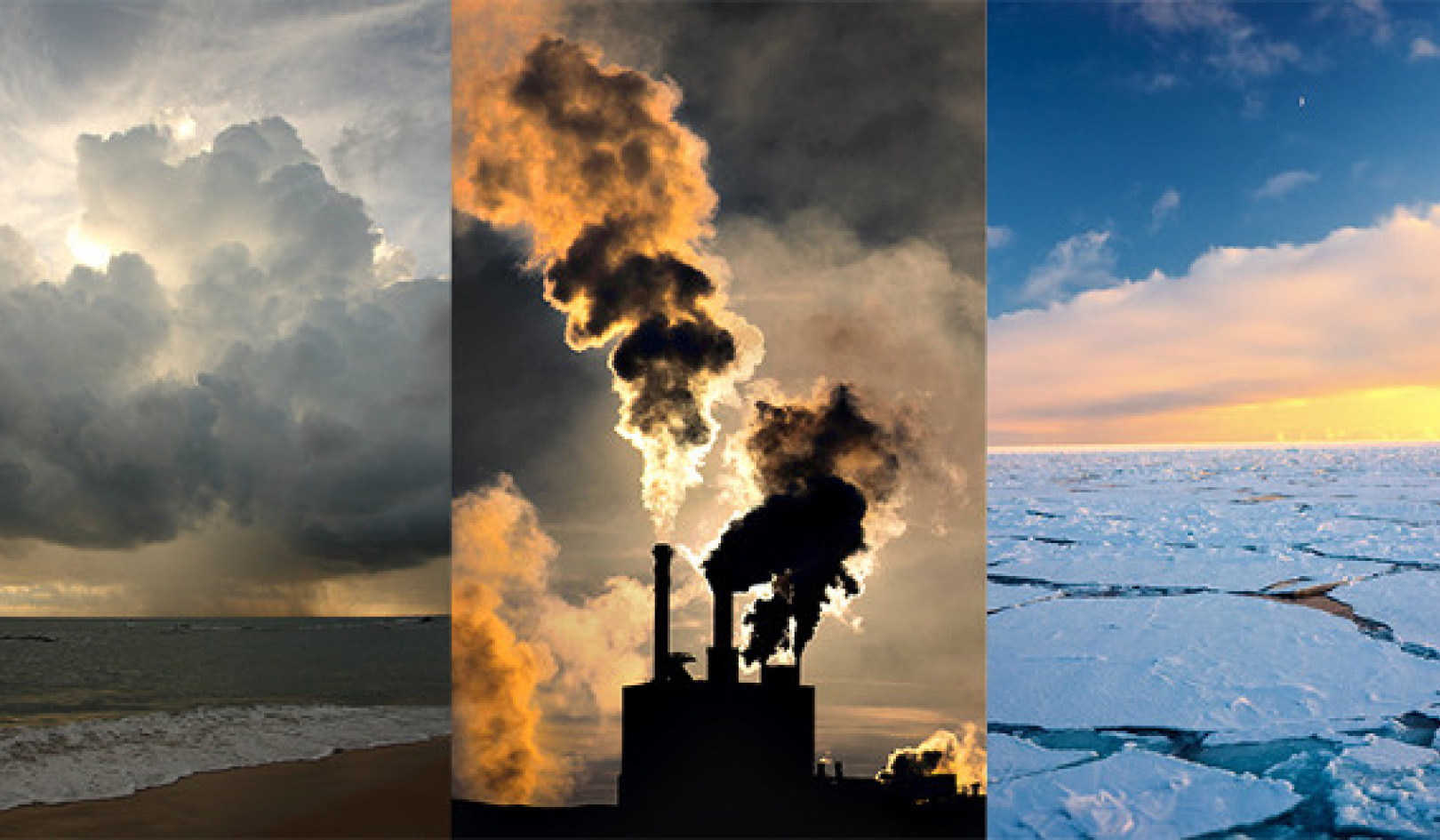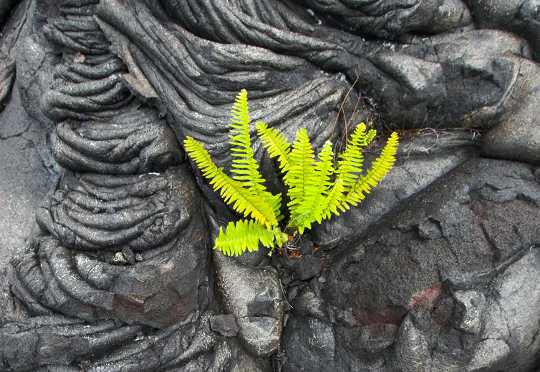
Some species can do well in the face of extreme hardship. George Burba/Shutterstock
Sixty-six million years ago, an asteroid struck the Earth. The world was plunged into darkness, killing the dinosaurs and over 90% of all species alive. Today, every living thing descends from the handful of surviving species. But not all survivors thrived.
Some groups – birds and placental mammals, butterflies and ants, sunflowers, grasses – diversified, taking advantage of the devastation. Some, like crocodiles and turtles, didn’t. And still others, like multituberculate mammals and champsosaurus, survived the asteroid but went extinct in the aftermath.
Why the difference? Surprisingly, what separated winners and losers wasn’t how hard extinction hit them. Rather, winners had qualities that made them adaptable and competitive after the extinction: they were fast-growing, mobile, cooperative and clever.
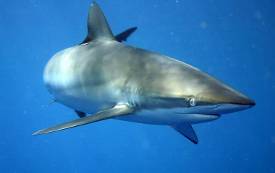 Sharks, great survivors, weren’t great innovators. Wikipedia
Sharks, great survivors, weren’t great innovators. Wikipedia
Some groups were completely eliminated: dinosaurs, pterosaurs, plesiosaurs and ammonites. Obviously, they couldn’t take part in a recovery. But among survivors, the groups that won out tended to be those hit hard by extinction.
Crocodilians, turtles and sharks were spared the brunt of the extinction, but aren’t especially diverse now. Meanwhile, groups that dominate today were devastated. Snakes and lizards saw over 80% extinction. Mammals were hit harder, suffering 90% extinction. Perhaps three bird species survived, suggesting extinction rates of 99.9% or more.
These groups were winners only in a relative sense – 99.9% extinction is terrible, but beats 100% extinction among tyrannosaurs. But while these animals initially suffered, they thrived when the dust literally settled. Four things gave them an edge.
Metabolism
First, winners had high metabolisms. Metabolic rate is how fast biological processes happen – meaning chemical reactions letting organisms grow, move, digest and reproduce.
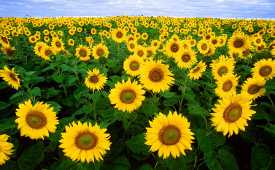 Fast-growing sunflowers complete their lives in a summer. Wikipedia
Fast-growing sunflowers complete their lives in a summer. Wikipedia
Higher metabolism requires more food. This was initially a liability for warm-blooded birds and mammals during the impact winter, when plants couldn’t photosynthesise food. But afterwards, being able to eat, grow and breed fast let birds and mammals rapidly increase their numbers, compete effectively, and colonise new habitats. Fast-growing flowering plants, especially grasses, flourished at the expense of slower-growing species.
Even within these groups, we see high metabolism providing an edge. Among mammals, placental mammals, with their higher metabolisms, outcompeted marsupials. Passerines, the most diverse group of birds, also have higher metabolic rates than other birds.
Mobility
Second, mobility promotes adaptability. Flight let birds, bats, butterflies and ants colonise new habitats, then diversify. Mammals, being highly mobile, quickly invade new habitats – think rabbits in Australia, or deer in New Zealand – in a way that turtles don’t.
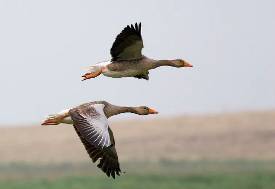 Graylag geese in flight. Wikipedia
Graylag geese in flight. Wikipedia
Flowering plants also evolved tricks – fruits, parachutes, burs, floating husks – to let wind, water or animals carry their seeds. It’s harder to displace competitors once they’re established, so being first into a new habitat provides a massive competitive advantage.
Cooperation
Third, winners tend to cooperate. Lions and wolves form prides and packs to take down prey and defend territory, elephants and zebras use herds for defence. Birds flock to find food and evade predators.
Ants and mound-building termites assemble vast family groups, outcompeting solitary insects. Birds, mammals and social insects also cooperate with relatives by feeding and caring for offspring, preserving their genes more efficiently.
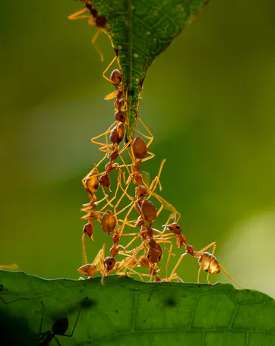 Ants cooperate. frank60/Shutterstock
Ants cooperate. frank60/Shutterstock
Meanwhile, some species cooperate with other species. Leafcutter ants and termites form alliances with fungi, cultivating them in return for food. Flowering plants give away nectar and fruit to animals, which then pollinate flowers and spread their seeds. By cooperating, these species compete more effectively, so cooperative animals like ants, elephants and orcas tend to play bigger roles in the ecosystem than solitary ones like alligators and turtles.
Intelligence
But maybe the most remarkable trend is the rise of intelligence. Mammals and birds have the largest brains of any animals. The largest-brained mammals, the placentals, have outcompeted marsupials and egg-laying monotremes. The most diverse birds, the passerines and parrots, are the brainiest.
Among insects, the social insects – ants, bees, termites – have complex behaviours that emerge from interactions of unintelligent individuals. This phenomenon is known as swarm intelligence, and not coincidentally, these insects dominated ecosystems after the asteroid winter.
But intelligence doesn’t just make animals more competitive. It accelerates adaptation, because the first step in changing your DNA is changing your mind.
For example, before mammals could evolve into whales, they first had to learn to swim and fish, only afterwards could natural selection create flippers and sonar. Before horses could evolve, their omnivorous ancestors switched to a vegan diet, then, natural selection favoured tall-crowned teeth and complex guts to break down tough plants. Behaviour leads; genes follow.
The greater an animal’s behavioural flexibility, the more tricks it can learn, and so the greater its adaptive potential. Animals don’t consciously decide their evolutionary futures. But they do choose what to eat, how to forage or where to live.
Whale ancestors didn’t dream of becoming dolphins, but they did dream of catching fish, and they imagined new fishing grounds. Being able to learn from yesterday, process information in dreams tonight, imagine different outcomes tomorrow – learning, memory processing, creativity – increase the number of potential evolutionary futures.
No accident
The continents were isolated in the early Cenozoic era just after the asteroid hit. Yet remarkably similar ecosystems dominated by mammals and birds evolved independently in South America, Africa, Australia and the Eurasian-North American supercontinent. That implies these groups’ dominance wasn’t an accident.
What’s striking is that these trends weren’t new – dinosaurs show similar patterns. Dinosaurs of the Cretaceous period had higher growth rates than their ancient Triassic ancestors. They were more mobile, some were fast runners, others – birds – flew.
The brains of these later dinosaurs were larger than earlier counterparts. T. rex was faster, smarter and had a faster metabolism than its forebears. Many – ceratopsians, duckbills, avimimids – show herding behaviours unknown from earlier dinosaurs.
During the asteroid winter, the rules briefly changed. Warm-blooded, fast-moving, cooperative, intelligent birds, mammals and dinosaurs fared poorly against turtles and alligators. Dinosaurs vanished. Afterwards, these trends reasserted themselves.
Evolution may offer us some lessons here. Be quick. Move to find new opportunities. Work with others. Try new things. But above all, change – adapt.
These are almost always good strategies, but especially when you’re down, trying for a comeback.![]()
About the Author
Nick Longrich, Senior Lecturer in Evolutionary Biology and Paleontology, University of Bath
This article is republished from The Conversation under a Creative Commons license. Read the original article.
Books on The Environment from Amazon's Best Sellers list
"Silent Spring"
by Rachel Carson
This classic book is a landmark in the history of environmentalism, drawing attention to the harmful effects of pesticides and their impact on the natural world. Carson's work helped to inspire the modern environmental movement and remains relevant today, as we continue to grapple with the challenges of environmental health.
Click for more info or to order
"The Uninhabitable Earth: Life After Warming"
by David Wallace-Wells
In this book, David Wallace-Wells offers a stark warning about the devastating effects of climate change and the urgent need to address this global crisis. The book draws on scientific research and real-world examples to provide a sobering look at the future we face if we fail to take action.
Click for more info or to order
"The Hidden Life of Trees: What They Feel, How They Communicate?Discoveries from A Secret World"
by Peter Wohlleben
In this book, Peter Wohlleben explores the fascinating world of trees and their role in the ecosystem. The book draws on scientific research and Wohlleben's own experiences as a forester to offer insights into the complex ways that trees interact with one another and the natural world.
Click for more info or to order
"Our House Is on Fire: Scenes of a Family and a Planet in Crisis"
by Greta Thunberg, Svante Thunberg, and Malena Ernman
In this book, climate activist Greta Thunberg and her family offer a personal account of their journey to raise awareness about the urgent need to address climate change. The book provides a powerful and moving account of the challenges we face and the need for action.
Click for more info or to order
"The Sixth Extinction: An Unnatural History"
by Elizabeth Kolbert
In this book, Elizabeth Kolbert explores the ongoing mass extinction of species caused by human activity, drawing on scientific research and real-world examples to provide a sobering look at the impact of human activity on the natural world. The book offers a compelling call to action to protect the diversity of life on Earth.





















